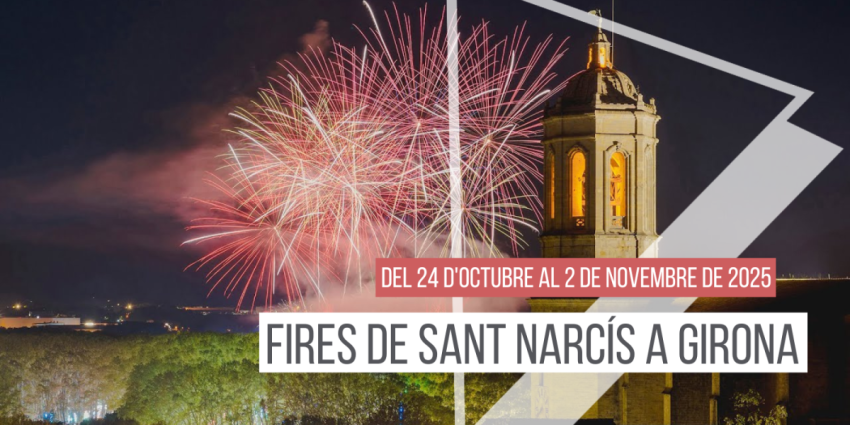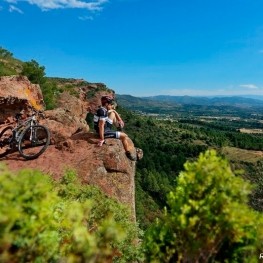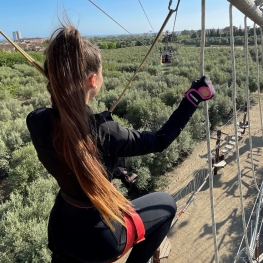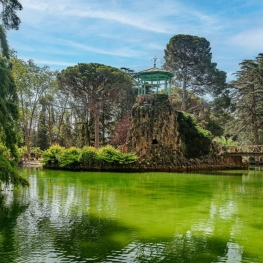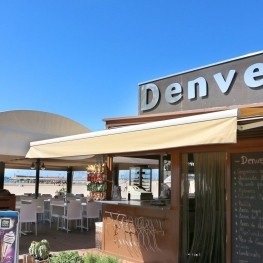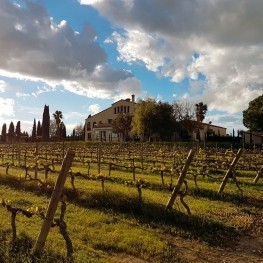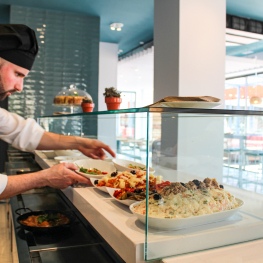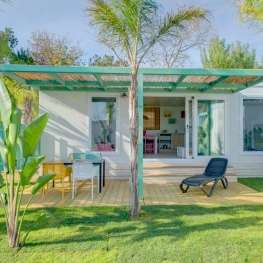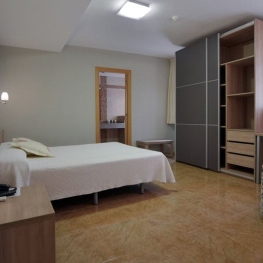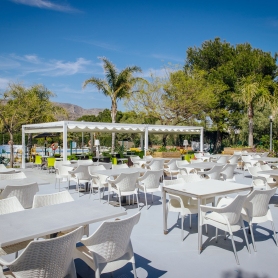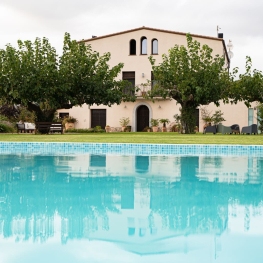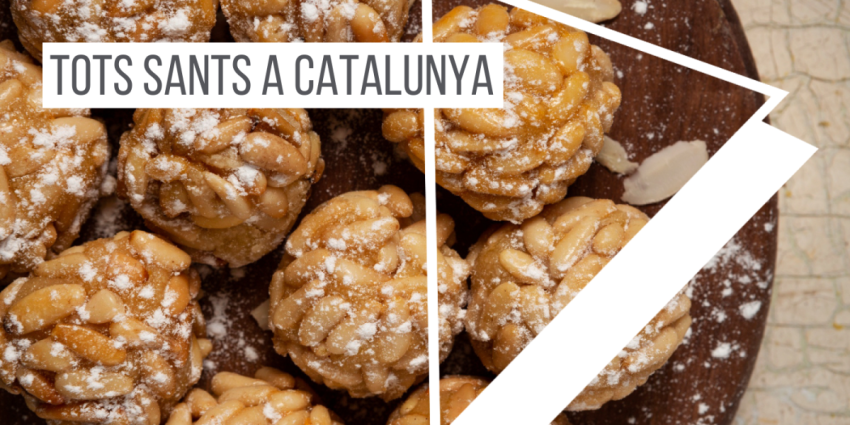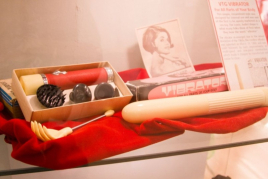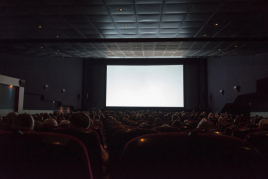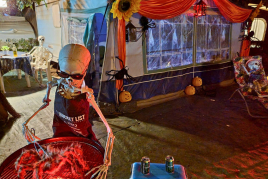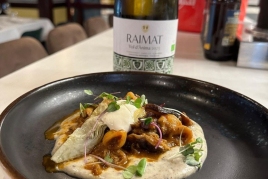Route through Mont-Roig del Camp
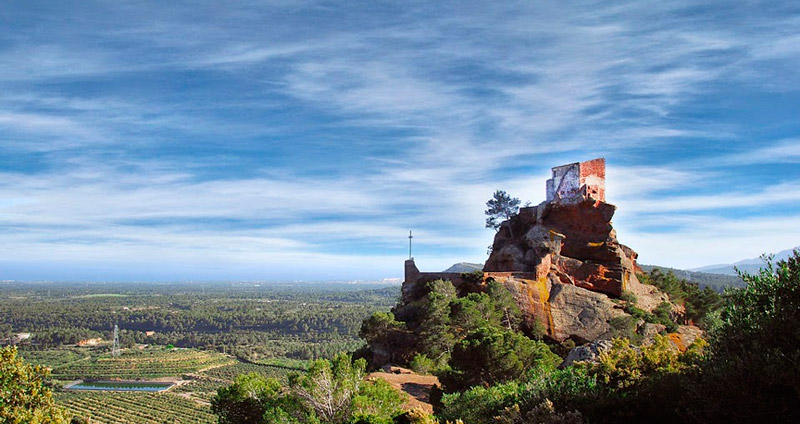
"All my work is conceived in Mont-roig." The appointment is neither more nor less than Joan Miró, universal Catalan, and the town to which it refers, Mont-roig del Camp, in the Baix Camp region. So if you want to know the streets and light that inspired the artist, follow us in this itinerary we propose, in the heart of the Costa Dorada. We will put the cherry on the way to the hermitage of the Virgen de la Roca, a singular place, a motive of legends, and also known by Miró.
Mont-roig del Camp - Miami Playa is the full name of the municipality. Like others of the Costa Dorada, it is composed of a historical nucleus a few kilometers inland, and a population by the sea very devoted to tourism, with restaurants, hotels and apartments in abundance, and also kilometers and kilometers of beach and some coves sensational If you go in summer, do not miss the opportunity to soak yourself somewhere in Miami Playa. Today, however, we propose a route through Mont-roig del Camp, where the artist Joan Miró spent long periods, and the mont-rogencs practically consider him a son here.
At present Mont-roig, the city of the interior, has about eleven thousand inhabitants and to place it say for example that it is located about 15 kilometers south of Reus, the capital of the region. Without highlighting especially for having steep streets, it is true that its historic center is slightly sloping, as our legs will immediately notice with the proposed route. Some streets that have been largely remodeled in recent years, and therefore if you visited Mont-roig some time ago, it may be a good time to return and get to know the renovated old town.
'School of children' and 'School of girls'
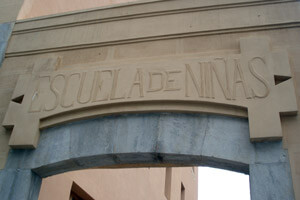 We propose to start the itinerary at the junction between Agustí Sardà, Industria, Fuente and Poniente streets, a space from where we can partially perceive the appearance of the historic quarter of Mont-roig, with the houses that seem to pile on top of each other, and with a source where we can take liquid provisions if we need to start the trip and where we have the shields of the municipality and Catalonia. Of all the mentioned streets we chose the one of Poniente, and then we left it following the indication of the Old Church. We are on Calvario street.
We propose to start the itinerary at the junction between Agustí Sardà, Industria, Fuente and Poniente streets, a space from where we can partially perceive the appearance of the historic quarter of Mont-roig, with the houses that seem to pile on top of each other, and with a source where we can take liquid provisions if we need to start the trip and where we have the shields of the municipality and Catalonia. Of all the mentioned streets we chose the one of Poniente, and then we left it following the indication of the Old Church. We are on Calvario street.
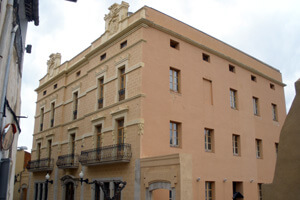 When it ends, we go to the left, and we find the first interesting building in Mont-roig, that of the old schools. Today Casa de Cultura Agustí Sardà and home of the public library Joan Miró, it is a neoclassical building with Renaissance symmetry façade with two monarchical crowns on the top and two entrance portals on both sides where the letters have been expressly preserved who signed up: on the left portal (looking at the façade), "School for children" and on the one on the right, "School for girls". The doors of the balconies present decorative elements.
When it ends, we go to the left, and we find the first interesting building in Mont-roig, that of the old schools. Today Casa de Cultura Agustí Sardà and home of the public library Joan Miró, it is a neoclassical building with Renaissance symmetry façade with two monarchical crowns on the top and two entrance portals on both sides where the letters have been expressly preserved who signed up: on the left portal (looking at the façade), "School for children" and on the one on the right, "School for girls". The doors of the balconies present decorative elements.
From this point the street of the Virgin of the Rock in ascent and to left we leave the street of the Call, without remarkable elements, until with a curve of 180 degrees we take the street of San Antonio.
The 'Cathedral of the Baix Camp'
In this street we have the hermitage of San Antonio Abad, from the 19th century and converted into a house and old houses with interesting elements, such as that of Joan Borràs, with a beautiful door and portal that, according to the inscription that shines, is from 1756. For the back we come to the New Church of San Miguel Arcángel and we can turn it around and check that it is of considerable dimensions, to the point that there is someone who has baptized it as the Cathedral of Baix Camp. 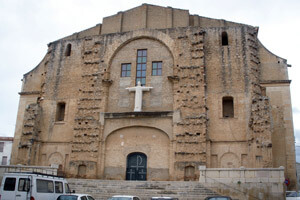 Who knows if by its measures, or perhaps by the curious facade, unfinished, with outstanding angular stones and with an image of Christ with open arms in cross that reminds us to that of Rio de Janeiro. The church has no bell tower and it seems that in the same place there had been a castle, already in the 12th century. The first stone of the church was put on October 25, 1801, as reported in the inscription on the outside wall, but wars and confiscations stopped the project and the first mass did not arrive until 1943, thanks to the efforts of the priest Cayetano Ivern. That is why the square where we are, where the facade of the church, is named after this priest. If you find the temple door open, enter to admire the colorful frescoes by Jaume Minguell.
Who knows if by its measures, or perhaps by the curious facade, unfinished, with outstanding angular stones and with an image of Christ with open arms in cross that reminds us to that of Rio de Janeiro. The church has no bell tower and it seems that in the same place there had been a castle, already in the 12th century. The first stone of the church was put on October 25, 1801, as reported in the inscription on the outside wall, but wars and confiscations stopped the project and the first mass did not arrive until 1943, thanks to the efforts of the priest Cayetano Ivern. That is why the square where we are, where the facade of the church, is named after this priest. If you find the temple door open, enter to admire the colorful frescoes by Jaume Minguell.
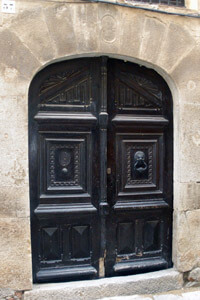 As you can guess, if there is a temple that bears the name "new" church, it will be that in one place or another there is an "old" one. This is very close, just follow the Calle Mayor and you have it there. Its history has been a constant of extensions and modifications since it began to be built at the end of the 12th century. Of the construction that has arrived at our days, several elements stand out, such as the double classic-style portal -with columns and a triangular tympanum-, the bell tower, from the 16th century, and the neoclassical fountain that is attached to the side wall that It overlooks the Joan Miró square and we find after crossing an arch that joins the church with the neighboring houses.
As you can guess, if there is a temple that bears the name "new" church, it will be that in one place or another there is an "old" one. This is very close, just follow the Calle Mayor and you have it there. Its history has been a constant of extensions and modifications since it began to be built at the end of the 12th century. Of the construction that has arrived at our days, several elements stand out, such as the double classic-style portal -with columns and a triangular tympanum-, the bell tower, from the 16th century, and the neoclassical fountain that is attached to the side wall that It overlooks the Joan Miró square and we find after crossing an arch that joins the church with the neighboring houses.
The artist's old interpretation center
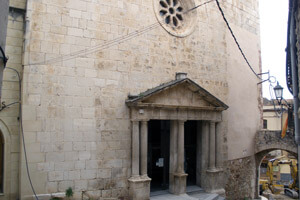 The Old Church does not fulfill religious functions today, unless we consider art as a religion. And it is that the interior occupied for years the Miró Center, a place of interpretation of the work of Joan Miró, which is currently located in the Mas Miró. The Tourism Office of the Mont-Roig nucleus is located in the Church and it has also been adapted as a multipurpose space where cultural events of all kinds are held.
The Old Church does not fulfill religious functions today, unless we consider art as a religion. And it is that the interior occupied for years the Miró Center, a place of interpretation of the work of Joan Miró, which is currently located in the Mas Miró. The Tourism Office of the Mont-Roig nucleus is located in the Church and it has also been adapted as a multipurpose space where cultural events of all kinds are held.
The Barcelonan discovered Mont-roig the life of the countryside, the vineyards, the olive groves and since 1920 he stayed for long periods, later combining them with the trips to Paris. The mass tribute paid to him on April 29, 1979, is still remembered in the town.
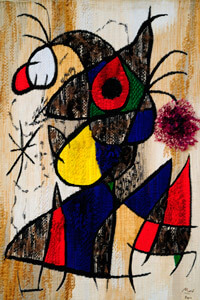 Mont-roig does not have original works by the artist, but at Mas Miró we will see some reproductions, such as the tapestry The lizard of the golden feathers or the six Miró dolls, as well as several audiovisuals about the genius.
Mont-roig does not have original works by the artist, but at Mas Miró we will see some reproductions, such as the tapestry The lizard of the golden feathers or the six Miró dolls, as well as several audiovisuals about the genius.
In the same plaza of the church we are struck by a plaque on the wall of a house where it is said that Anton Benaiges and Nogués were born there . This name is surely not as well known as that of Miró, but it is worth explaining, even if it is to remember for a moment all those people who died at the hands of fascism, that Benaiges was a teacher of the Second Republic who went to teach in a town in the province of Burgos that applied an innovative teaching method, called Freinet. Benaiges was murdered, at 33 years of age, as soon as the war began, in 1936.
We are already finishing the itinerary through the historic center of Mont-roig and to get to the point where we left discovering some more streets, we can do everything from Francisco Riba and Maestro to the Plaza de Miramar and go down Cristóbal Colom street to the street of Industry, which we will take to the right.
Two chapels above a reddish rock
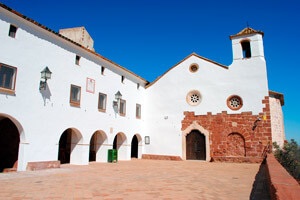 But behold, within the same municipal area - quite extensive, by the way there is a place that you can not miss: the hermitage of the Virgen de la Roca. In fact there are two, of hermitages, the one next to the other, the one that we have just said and that of San Ramón de Penyafort. In this place, quite spectacular, we will understand why Mont-roig has this name, since it is a mountain -or maybe we should say an immense rock- of reddish color and we will know a point of great devotion for the mont -rogencs and that he knows with certainty that Miró also visited and admired.
But behold, within the same municipal area - quite extensive, by the way there is a place that you can not miss: the hermitage of the Virgen de la Roca. In fact there are two, of hermitages, the one next to the other, the one that we have just said and that of San Ramón de Penyafort. In this place, quite spectacular, we will understand why Mont-roig has this name, since it is a mountain -or maybe we should say an immense rock- of reddish color and we will know a point of great devotion for the mont -rogencs and that he knows with certainty that Miró also visited and admired.
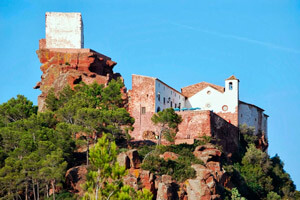 The hermitages seem miraculously suspended above the rock. Despite the steepness of the mountain, you do not need a big or complicated excursion to get there, because with a vehicle a good piece arrives and you only need a few meters to face the world of the Virgin of the Rock, a construction that has references since 1230 and that more than hermitage must be defined as a sanctuary, with several buildings, partly taking advantage of the reddish stone of the place. A little further up, the hermitage of San Ramón de Penyafort is a small rectangular construction dating from 1586. There we will find the path of the Areny to reach a viewpoint. If the views from the hermitages were already impressive, from the viewpoint we can still see more with the panoramas of the surroundings. A phenomenal place that has given rise to legends such as the slip of the Moorish king and that puts an end to today's exit.
The hermitages seem miraculously suspended above the rock. Despite the steepness of the mountain, you do not need a big or complicated excursion to get there, because with a vehicle a good piece arrives and you only need a few meters to face the world of the Virgin of the Rock, a construction that has references since 1230 and that more than hermitage must be defined as a sanctuary, with several buildings, partly taking advantage of the reddish stone of the place. A little further up, the hermitage of San Ramón de Penyafort is a small rectangular construction dating from 1586. There we will find the path of the Areny to reach a viewpoint. If the views from the hermitages were already impressive, from the viewpoint we can still see more with the panoramas of the surroundings. A phenomenal place that has given rise to legends such as the slip of the Moorish king and that puts an end to today's exit.
The slip of the Moorish king
There was once a Moorish king, who with his horse, went to the Hermitage of the Rock. He climbed up the San Ramón hermitage and stole the silver lamp that was there. He went down, entered the church and there stole the jewels of the Virgin. While stealing, clouds began to appear, it was getting dark, and there were thunder and lightning. The king went out to the square, climbed on top of the horse and left, carrying everything he had stolen. But when the horse heard the crack of thunder and lightning that did not stop, it went wild, and when it was on the "descent of the Moorish king," it slipped, and horse and king fell down a ravine and there they died. On that descent you can still see the horse's slips. Some say that you can still see the silhouette of the Moorish king and that of the horse, on the other side of the ravine; if the herbs do not cover it.
What to do
Muntanyes de la Costa Daurada
The municipalities of the Costa Daurada Mountains make up a territory of…
Jumpland Aventura Ecològica
Cambrils (a 13.4 Km)Venture into the world of Jumpland Aventura, a park for everyone who…
Where to eat
Restaurant Denver Cambrils
Cambrils (a 12.5 Km)From the legendary Xiri to the current restaurant, Denver offers a creative…
L'Orangerie de Clos Barenys
Vila-seca (a 16.4 Km)Under our fires, we prepare haute Mediterranean cuisine by selecting the finest…
Arena Tapas Restaurant
Salou (a 17.9 Km)Enjoy an innovative cuisine, with high-quality local products of proximity, with an…
Where to sleep
Càmping Resort Alannia Els Prats
Mont-roig del Camp (a 4.9 Km)Located in Miami Platja, Tarragona, this is the ideal place to spend…
Hotel Fonda El Camí
Cambrils (a 11.8 Km)Located in the historic center of Cambrils, 40 rooms with all amenities.…
Càmping Alannia Costa Dorada
Vandellòs i l'Hospitalet de l'Infant (a 10.4 Km)Alannia Costa Dorada is located in an environment with direct access to…
Casa Rural Mas Montbrió Belvedere
Cambrils (a 11.7 Km)Mas Montbrió Belvedere is the ideal place to enjoy nature and the…

